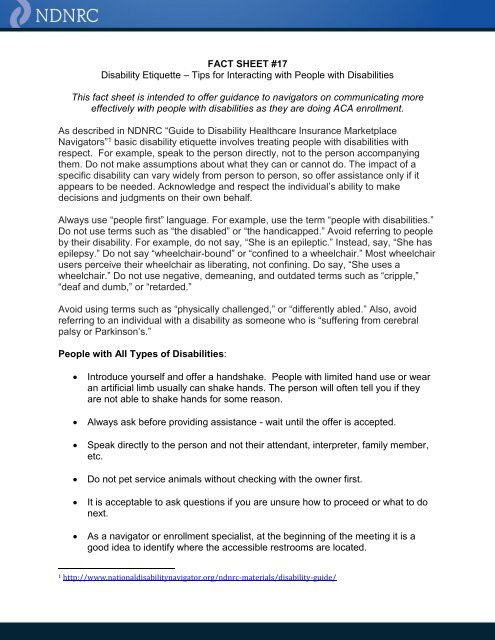Fact-Sheet-17-Disability-Etiquette
Fact-Sheet-17-Disability-Etiquette
Fact-Sheet-17-Disability-Etiquette
Create successful ePaper yourself
Turn your PDF publications into a flip-book with our unique Google optimized e-Paper software.
FACT SHEET #<strong>17</strong><strong>Disability</strong> <strong>Etiquette</strong> – Tips for Interacting with People with DisabilitiesThis fact sheet is intended to offer guidance to navigators on communicating moreeffectively with people with disabilities as they are doing ACA enrollment.As described in NDNRC “Guide to <strong>Disability</strong> Healthcare Insurance MarketplaceNavigators” 1 basic disability etiquette involves treating people with disabilities withrespect. For example, speak to the person directly, not to the person accompanyingthem. Do not make assumptions about what they can or cannot do. The impact of aspecific disability can vary widely from person to person, so offer assistance only if itappears to be needed. Acknowledge and respect the individual’s ability to makedecisions and judgments on their own behalf.Always use “people first” language. For example, use the term “people with disabilities.”Do not use terms such as “the disabled” or “the handicapped.” Avoid referring to peopleby their disability. For example, do not say, “She is an epileptic.” Instead, say, “She hasepilepsy.” Do not say “wheelchair-bound” or “confined to a wheelchair.” Most wheelchairusers perceive their wheelchair as liberating, not confining. Do say, “She uses awheelchair.” Do not use negative, demeaning, and outdated terms such as “cripple,”“deaf and dumb,” or “retarded.”Avoid using terms such as “physically challenged,” or “differently abled.” Also, avoidreferring to an individual with a disability as someone who is “suffering from cerebralpalsy or Parkinson’s.”People with All Types of Disabilities:Introduce yourself and offer a handshake. People with limited hand use or wearan artificial limb usually can shake hands. The person will often tell you if theyare not able to shake hands for some reason.Always ask before providing assistance - wait until the offer is accepted.Speak directly to the person and not their attendant, interpreter, family member,etc.Do not pet service animals without checking with the owner first.It is acceptable to ask questions if you are unsure how to proceed or what to donext.As a navigator or enrollment specialist, at the beginning of the meeting it is agood idea to identify where the accessible restrooms are located.1 http://www.nationaldisabilitynavigator.org/ndnrc-materials/disability-guide/
ConteúdoObrigado por adquirir este produto.Leia atentamente estas instruções de operação para conhecer a forma correta deutilizar este aparelho. Depois da leitura, guarde este manual para consultarfuturamente.2
Speak directly to the person in your normal voice and not to their interpreter, if aninterpreter is present.Let the person establish their preferred method of communication for yourconversation, such as lip reading, sign language, note writing. When speakingmake eye contact.Feel free to use gestures and visual cues, such as holding up items that you arediscussing.Explain if there is an interruption such as a phone ringing, knock at the door orany activity that is disruptive outside of your office.People with Speech and Language DisordersPeople with speech and language disorders may take longer to communicatewith you – be patient and respectful.Be sensitive and do not interrupt or finish the person’s sentence.Ask one question at a time, giving the person time to respond before moving on.If the person uses any assistive technology devices, make sure the devices arealways within the person’s reach.People with Cognitive or Intellectual DisabilitiesKeep communication simple, using short sentences and completing one topicbefore moving to the next topic.If possible, use pictures or other visual aids.Ask if the person has any questions or if there is anything they would like for youto clarify. If you feel it is necessary, repeat what you understand the person to besaying and ask for confirmation if your understanding is correct.People with Mental Health or Behavioral Health DisabilitiesIf a person seems anxious or agitated, speak calmly and offer to repeatinformation.If a person seems nervous or confused, be willing to break things down step-bystepto help them understand the application procedure.
Respect a person’s choice of language or terminology. For example, if they askyou to refer to something as a “mental health condition” instead of a “mentalillness”, listen to their request. If they say they don’t have a mental healthcondition, but identify mental health treatment as a medical need, don’t disagree.Just help them select a plan with appropriate treatment.If a person becomes upset or anxious, they may be confused or overwhelmed.Speak in a normal, calm tone of voice, repeat necessary information andreassure them.If a person brings an assistor, be sure to speak directly to the person, not to theassistor.Know the local mental health crisis number to contact if needed.American Association on Health and <strong>Disability</strong> (AAHD)National <strong>Disability</strong> Navigator Resource Collaborative (NDNRC)110 N. Washington Street, Suite 328JRockville, MD 20850301.545.6140/contact@aahd.uswww.nationaldisabilitynavigator.orgCopyright © 2015 – American Association on Health and <strong>Disability</strong>


